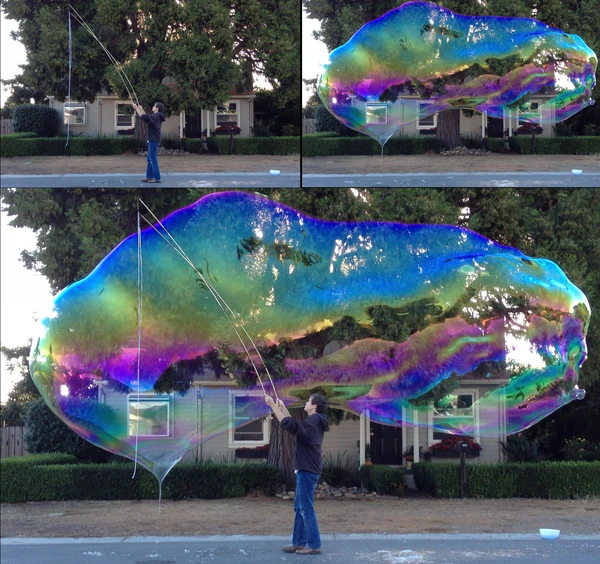Creating giant and super-giant bubbles can be tricky. The larger a bubble, bubble wand, or tri-string loop is the harder it can be to close a lasting bubble. This page offers some tips that may help.
-

Composite of a super-giant bubble with the starting position photoshopped in to give a sense of the size. The pictures are frame grabs from video shot on a tripod to preserve the scale of the elements. Here is video of another bubble from the session: http://www.youtube.com/watch?v=A_xUBQl4zwk&hd=1
Considerations[]
Super-giant bubbles (like the one pictured above) have special needs that not even "giant" bubbles have. The conditions, techniques, bubble equipment, and bubble juice that work for very large bubbles may not work (or not work very well) for super-giants like the one shown above.
Conditions. Even with bubble-juice and equipment perfectly appropriate for super-giants, you may not have any luck at all if the conditions aren't right. Such bubbles are often not possible even on days when it is possible to create very large bubbles. For example, it might be possible to create 4-foot (120 cm) diameter bubbles that last 30 seconds or more on a day when a 6-foot (180 cm) diameter bubble lasts only seconds. On such a day, you might not be able to close super-giant bubbles even though "giant" bubbles are pretty easy. The very largest bubbles seem to need cool temperatures and high humidity. 40F-55F (4.5C - 13C) and 80% (or better) humidity seems to be good conditions for the very largest bubbles.
Keep in mind that high humidity at low temperatures is different from high humidity at higher temperatures. As the temperature approaches freezing there is much less moisture in the air than at the same relative humidity and a higher temperature. Also, the flow characteristics (rheology) of a bubble juice changes. So, a mix may need to be fine-tuned to the temperature range under which it will be used.
Bubble Juice. The same juice that works well for pretty big, even giant, bubbles may not work well for super-giants. If you are using a bubble juice that has not been established to work well for super-giants, it is possible that the bubble juice needs tuning. If you are getting started with super-giants, we recommend that you start with a bubble juice recipe that is known to be good for super-giant bubbles.
Techniques and Troubleshooting[]
Closing Bubbles[]
When the session starts, do a few tests to see what works best in the current conditions:
- Create a few medium-sized bubbles with a diameter of about 3 feet (1 meter) to make sure that the juice is working well.
- Dip the loop and then open it wide to get a sense of the largest tube that can be made under the conditions. Don't try to close these. The goal is to get a sense of the limits of your setup in the current conditions. Do it a few times to get a sense of the range. Later in your session, you can use this information to help you decide when you should start closing the bubbles. Pay attention to the color changes as the tube grows. Pay close attention to the colors at the top of the bubble just before it breaks. When closing bubbles, you will want to start before you see those colors.
- Try closing bubbles when they reach about one-half the size of the average tube found in the previous step.
- When closing bubbles try different grow speed/closing speed combinations. Sometimes you need to grow the bubble quickly and close it quickly. Other times, you may need to grow it slow and close it quickly or grow quickly and close gently.
- If the bubble seems like it is sticking to the string when you close, try gently (or not so gently) moving the wand up and away from you. Sometimes, the bubble releases best if the wicks moves vertically on release (after being brought to a closed position) than if the wick is pulled to the side. This may depend on the wick material.
- Try closing by moving only one handle. Sometimes when we move both handles, we introduce more stress on the bubble than if we only move one.
- Try turning your body as the loop closes to see if the inertia/wind helps.
- Avoid having the bubble moving towards you. It is often impossible to close a super-giant if the bubble is moving towards the bubbler.
- If the wind is moving the bubble, try walking in the direction of the bubble as you start to close to limit the added stress.
- Also, you always want to close a bubble as it's moving away from you. You can close bubbles in slightly windy conditions staying flat-footed, but in calm conditions you have to move back just a little the close the bubble.
More Tips. From Dustin Skye: "I like to lower my wand tips as I try to close a super giant. Lowering the tips of the poles causes the tips to move away from me slightly, decreasing the stress on the bubble film as it closes. This only works if the wind is very slight. If the wind is moving faster than the tips when I lower them, I'll walk toward the bubble to match speeds with it."
Tweaking Your Solution[]
Sometimes the juice will be successful at creating giants but not super giants. Occasionally, there is too much or too little polymer (the symptoms can be the same) or too little detergent.
[WIKI: ADD INFORMATION HERE ABOUT HOW TO TROUBLESHOOT]
Miscellaneous Tips[]
- Bring a variety of loop sizes and materials. Even when conditions seem theoretically perfect, there are days where super giants aren't possible. But, you might get great results with a smaller loop or a garland.
See Also[]
The Random Tips page has some helpful tips and tricks that also apply to giant bubbles.